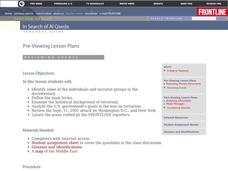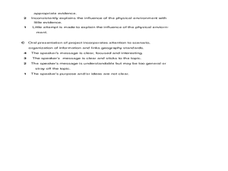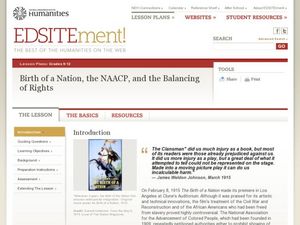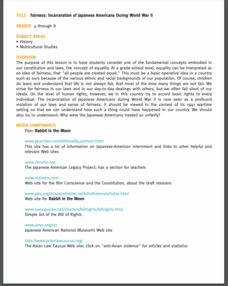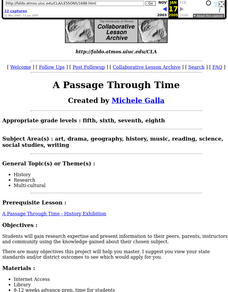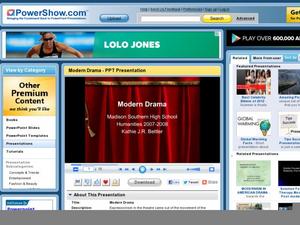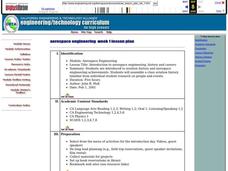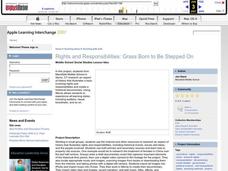Curated OER
Rings of Passion: Five Emotions in World Art
Pupils examine pieces of art and write a short essay on what emotions they feel by viewing it. They view a video clip and complete chart as they watch. They discuss how the writers of the program showed emotions in the clips.
Curated OER
Who's Who In Black History
Fourth graders examine the life and achievements of promident African-Americans. As a class, they participate in acting out various scenes of a play which represents the Civil Rights era. They discuss how the world might be different...
Curated OER
In Search of Al Qaeda
Pupils view a PBS Frontline video online entitled, "In Search of Al Qaeda." They complete pre-viewing activities in which they examine the use of primary sources. They look at the key groups and individuals and the history of terrorism....
Curated OER
Growth in A City Neighborhood
Students take the "role" of city planner. They overlay a map of one area of the city in the past, present, and projected future project. Students discuss reasons for selecting the special features of the area. The activity refers...
Curated OER
Birth of a Nation, the NAACP, and the Balancing of Rights
Eleventh graders analyze primary sources. In this US History instructional activity, 11th graders interpret written information. Students evaluate arguments and draw conclusions. Students develop and defend a position.
Curated OER
Hollow Form - Monsters - Beasties That Never Were
Students investigate Medieval art Gargoyles/Beasties and creatures used for animation films, design an original monster, and create a hollow clay form using hand building techniques.
Curated OER
Fairness: Incarceration of Japanese Americans During World War II
Young scholars examine fairness in relation to the incarceration of Japanese Americans during WWII. In this equality instructional activity, students watch a video "Rabbit in the Moon" and discuss what happened to the Japanese Americans...
Curated OER
City Desk with Malcolm X
High schoolers view a film about civil rights and the role Malcolm X played in the civil rights movement. They create a timeling about the events that occured from segregation to integration. They discuss discrimination as well.
Curated OER
Civil Disobedience Action Plan
Young scholars investigate incidences of civil disobedience. For this civil disobedience lesson, students watch a video and read a newspaper article on civil disobedience. Then, in groups, they search a current newspaper for examples of...
Curated OER
Crossing the Line: Jackie Robinson
Students participate in viewing The National Pastime, a film about Jackie Robinson's life. They discuss how Robinson was a hero and how they can learn from him. They work in groups using a graphic organizer to analyze Jackie Robinson...
Curated OER
Lewis and Clark in Your Local Park
Students read parts of the Journals of Lewis and Clark focusing on the descriptive writing of Meriwether Lewis. They examine pictures of animal and plant species, and listen to nature tapes. They simulate the experience of the explorers...
Curated OER
Teaching About Genocide
Students can find that genocide is a prevalent theme in world history.
Curated OER
A Passage Through Time
Young learners research and present information about a chosen subject to their peers, parents, instructors, and community. This lesson has a strong research and public speaking component, and would be ideal for your higher level students.
Curated OER
The U.S. Holocaust Memorial Museum
Ninth graders visit the US Holocaust Museum to witness the actions of the Nazis against the Jews during World War II. A great lesson if you are located near the museum or are planning a trip to the DC area.
Curated OER
Lesson: Urs Fischer: Controlling our Logic, Metaphors, and Semantics
Kids use poetry and contemporary art to start thinking about logic and personal expression. They read Sylvia Plath's poem "Metaphor," and critically examine the art of Urs Fischer. After working though a few logic problems they write...
Curated OER
Modern Drama
Upper graders can read all about the origins of modern drama. Each slide provides a paragraph of information related to key players, art movements, and time periods that shaped modern drama. It relates well to many aspects of literature...
Curated OER
An Eye for an Eye
High schoolers watch a view introducing them to modern Indian History. During the film, they answer discussion quesitons and discover the concept of non-violent civil disobedience. They share their responses with the class and write an...
Curated OER
Immigration/Migration: Today and During the Great Depression
Eleventh graders compare experiences of their families to those living through the Great Depression using famiy interviews, photographs, films and document from the Library of Congress.
Curated OER
Aerospace Engineering
Students are introduced to aviation history and aerospace engineering achievements. They assemble a class aviation history timeline from individual student research on people and events.
Curated OER
Write a Harry Potter Script
Examine the technique of writing a script and complete a worksheet in which young writers summarize a favorite chapter in a Harry Potter book. They practice public speaking by acting out the summarization scenes for classmates. Handouts...
Fu Jen Catholic University
Cry Freedom
If you are considering showing the film Cry Freedom, directed by Richard Attenborough, to your class, you might show them this presentation first. The slides contain background information about South Africa, apartheid, Steve Biko, and...
Curated OER
Rights and Responsibilities: Grass Born to Be Stepped On
Young scholars use the Internet and other resources to research an aspect of history that illustrates rights and responsibilities, including historical events, issues and ideas, and the people involved.
Curated OER
Revolutionary Money
Examine paper money from the American revolution! Historians study the paper bills and discuss the history of money. How has money changed over the times? Activities are included.
Curated OER
Stories of the American Experience
Students identify a veteran to interview. This could be a family member of one of students or someone contacted through an organization in the community. They use a storyboard to plan their movie about their subject.




